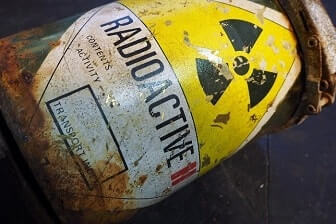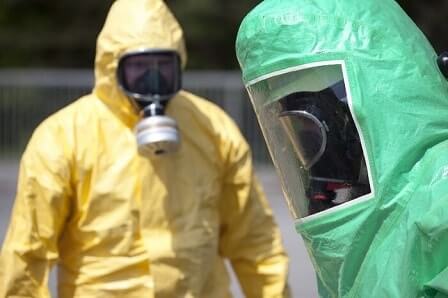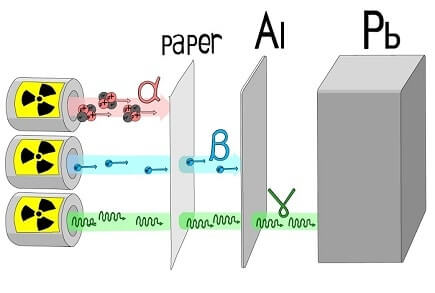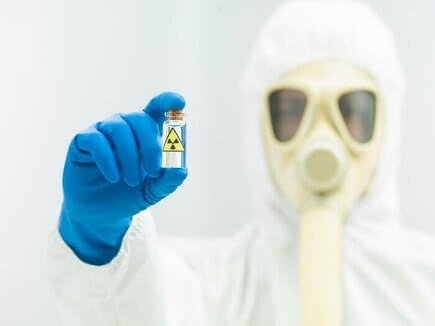

Providing enabling technologies to support you from Discovery to Delivery.
› Solutions ›Nuclear Industry
Radiation exposure arising from the operation of a nuclear power plant shall be kept as low as reasonably achievable. A nuclear power plant’s design and operation shall be implemented so that radiation exposure to workers can be limited as separately enacted.

The effective dose caused to a worker by radiation work shall not exceed an average of 20 milliieverts (mSv) per year reckoned over a period of five years, nor 50 mSv in any one year. The annual equivalent dose in the lens of the eye shall not exceed 150 mSv, nor shall the annual equivalent dose at any point on the hands, feet or skin exceed 500 mSv.
In order to keep individual radiation exposures low, additional dose constraints lower than the above mentioned shall be used at the nuclear facility. Annual doses over 20 mSv can be accepted only in justified exceptions.
The effective dose to a young person of no less than 16 but no more than 18 years of age who is involved in the use of radiation sources in the course of vocational training shall not exceed 6 mSv per year. The annual equivalent dose in the lens of the eye shall not exceed 50 mSv, nor shall the annual equivalent dose at any point on the hands, feet or skin exceed 150 mSv.

When applying the maximum values for radiation exposure, no allowance shall be made for exposure arising from immediate measures necessary to limit the radiation hazard resulting from an accident and to bring a radiation source under control. These measures shall be arranged so that the radiation exposure resulting from the situation is limited to the least possible.
If the radiation exposure resulting from measures referred to in paragraph 1 may exceed any of the dose limits prescribed in Section 3, then the measures shall be performed on a voluntary basis. The persons performing the measures shall be advised of the hazard pertaining to the said measures.
Except where the matter concerns the saving of human lives, the effective dose of a person involved in the measures referred to in this Section shall not exceed 0.5 Sv and the equivalent dose at any point on the skin shall not exceed 5 Sv.
Radiation protection at nuclear facilities shall be based on good planning of activities, appropriate working methods, up-to-date radiation protection methods, instruments and protective equipment, utilisation of prior experience as well as co-operation between the different organisation units within the nuclear facility. Commitment to the implementation of radiation protection concerns the whole staff of the nuclear facility.
The responsible manager shall ensure sufficient resources and authority for the personnel implementing radiation protection. The responsible manager shall especially monitor actions which aim to keep radiation doses low.
A unit with a responsibility for taking care of radiation protection work in practice and for co-ordinating related functions shall be established within the nuclear facility’s operating organisation. The radiation protection manager of the facility shall act as this unit’s head. Task and responsibility arrangements for the implementation of radiation protection shall be presented in documents concerning the operation of the facility
The radiation protection manager has to direct the implementation of radiation protection at the facility. In addition, he/she shall organise that radiation protection is developed and international experience in the field is followed.
Radiation protection unit shall know of the structure of the facility and general technical operating principles as well as the radiation sources at the facility. The unit shall monitor by measurements the radiation situation within the facility as well as oversee work and measures carried out in the controlled area of the facility as regards radiation protection.
Radiation protection unit shall organise that an adequate amount of radiation monitoring instruments and protective equipment is available. In addition, the unit shall ensure that these instruments and equipment are operable and that they are used according to the instructions given.
Radiation protection personnel shall have adequate authority to implement measures, which aim to keep radiation doses low, and the authority to interrupt working activities on grounds of radiation protection.
Category A shall include those workers whose effective dose caused by their work exceeds, or may exceed, 6 mSv per year, allowing for the possibility of a work-related incident resulting in abnormal radiation exposure, or an equivalent dose is or may be greater than three tenths of the dose limits stipulated for the lens of the eye, the skin, hands or feet.
Category B shall include those workers who are not classified as category A workers.
The following are the duties of the Medical Surveillance Team
Dose rate measurements and determinations of the concentration of airborne activity and surface contamination (surface activity) shall be systematically conducted at the facility. Based on the results of measurements, the workplaces are classified into controlled and supervised areas. Area outside of the controlled and supervised areas is an uncategorised area in terms of radiation protection.
If the effective dose may exceed 1 mSv in a certain area, the equivalent dose to an eye 15 mSv or the equivalent dose to hands, feet or skin 50 mSv per year, the area shall be defined at least as a supervised area.
Working conditions in the supervised area and, when necessary, individual exposure shall be monitored according to the nature and extent of radiation exposure. Radiation sources in the area and the associated radiological danger shall be appropriately marked. The markings shall, if necessary, indicate that the area is a supervised area.
Workers shall be provided with instructions on working in the supervised area, use of radiation sources and radiological danger associated with the sources. Radiological conditions of the supervised area, outlines of the area and adequacy of the protective measures shall be verified with regular inspections.
At least those premises of the facility, where the external radiation dose rate may exceed a value of 3 μSv/h or where a 40 hour weekly stay may cause an internal radiation dose exceeding 1 mSv per year, shall be defined as a controlled area.
|
Radioactive Substances |
Workplaces and Tools |
Workers |
|
|
Clothes Bq/cm2 |
Skin Bq/cm2 |
||
|
Alpha emitters (Radiotoxicity class 1) |
0.4 |
0.4 |
0.2 |
|
Other nuclides |
4 |
4 |
2 |

The premises of the controlled area shall be divided into zones based on external dose rate, surface contamination and concentration of airborne activity. There shall be at least three zones.
The following conditions shall be fulfilled in the premises of the lowest zone:
The highest zone consists of premises where only short-term, beforehand carefully planned stays are allowed. At least those premises, where one of the following conditions is fulfilled, belong to this zone:
External dose rate, surface contamination or concentration of airborne activity may locally exceed the classification limit if the sub-area in question is separated by access barriers and marked with signs indicating the radiation situation, potential stay limitations and protective equipment required. Exceptional radiation sources shall be always visibly marked.
The zone classification of an area and the grounds for it shall be clearly indicated with signs at the entrance. If the radiation situation of an area changes, the sign indicating the area’s classification shall be changed without delay to correspond with the new conditions.
The access to the controlled area shall be monitored. Premises except those of the lowest zone shall be locked up or monitored. Persons moving in the controlled area shall have a personal badge visible for identification and access right checking. Persons working in the area shall always have a personal dose meter (dosimeter). If the individual radiation dose received in a workplace may exceed 0,5 mSv per week, a dosimeter enabling real-time dose monitoring shall be additionally used. An alarming dosimeter (preferably with a dose rate alarm) shall be used if the dose rate may exceed 1 mSv per hour.
Radiation dose of visitors in the controlled area shall be measured. Group dosimeters may be used if the radiation dose measured is representative considering all individuals in a group.
At least protective overalls and shoe covers shall be used as protective clothing, complemented by necessary additional protective gear (protective gloves and shoes, respirators) required in the task. Protective overalls may be replaced by protective coats in justified exceptions if the contamination risk of clothes is low.

Eating, drinking and smoking are prohibited in the controlled area. Exceptions to this rule may be separately allocated cafeterias and break areas. In addition, an exception may be the use of water dispensers. However, these premises and dispensers may be used only under the supervision of the radiation protection personnel if it can be ensured by radiation measurements that their use will not cause any internal contamination to workers.
Hands and protective clothing of the personnel leaving the controlled area shall be checked with a measuring instrument for surface contamination. The area can be exited normally if the contamination limits of a worker are not exceeded. Measurement results exceeding the surface contamination limit shall be recorded. For the cleanup of the surface contamination of workers, the nuclear facility shall have appropriately equipped premises for the decontamination of individuals.
If it can be suspected based on the surface contamination measurements that a worker has received internal contamination, an immediate on-site measurement by using an internal radiation monitoring equipment shall be conducted.
A radiation work permit is needed for radiation work conducted in the controlled area. A permanent permit may be issued for routine and repetitive tasks. The methods and responsibilities for issuing of the radiation work permit shall be defined in the radiation protection procedures of the facility.
The radiation work permit or related documents shall include at least
The radiation work permit shall be visible at the workplace. The radiation protection personnel shall have the right and responsibility to inspect that the work performed in the workplace complies with the permit. Based on the monitoring of radiation work permits and work, records shall be kept of work which has caused significant radiation doses.
The aim of radiation protection training is to provide workers with preconditions for correct working in the controlled and supervised areas, prohibit unnecessary radiation exposure and influence to the accomplishment of the radiation protection goals. In addition, training shall give preconditions to act consistently if unpredictable situations occur at the workplace. As far as possible, work phases shall also be trained before they are performed in demanding workplaces as regards radiation protection.
Training provided to personnel working in the controlled area shall at least include the applicable parts of the radiation legislation and regulations issued by virtue of it, fundamentals of radiation and radiological risks, instructions for working in the controlled area as well as information on the monitoring of radiation exposure.
Training shall be given to all permanent and temporary workers of the nuclear facility working in the controlled area. In addition, specific radiation protection training shall be given to those persons whose work (e.g. work planning) affects significantly to the results of radiation protection.
In connection with giving training and instructions the worker’s responsibility for taking care of his/her own and other persons’ radiation safety shall be highlighted.
Radiation protection training at nuclear facilities shall be given to both domestic and foreign workers to an adequate extent.
Workers shall demonstrate the adequacy of their radiation safety knowledge in a written exam. A record shall be prepared of the exam, indicating the name of the worker who performed the exam and the name of the employer who evaluated it.
Radiation protection training shall be given already before the commissioning of the facility. In addition to the initial training, refresher training shall be organised at regular intervals. Radiation protection training can be considered to be qualified for both Finnish nuclear power plants, if the plant specific characteristics and differences have been taken into account in connection with training. For example, it is sufficient that written material is handed out to workers. On the same basis, radiation protection training in Sweden can also be approved at Finnish nuclear power plants.
Procedures on the implementation of radiation protection shall be established at the nuclear facility. The procedures shall include at least
Radiation protection procedures shall be kept up to date and evaluated regularly according to a way defined in the quality management system of the nuclear facility.